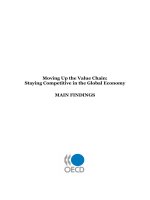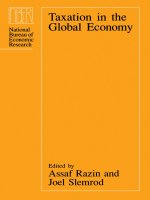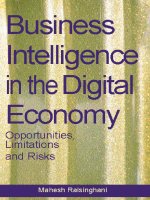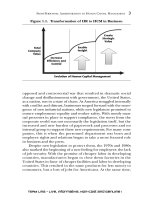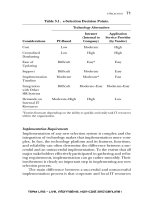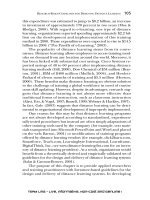9812705732 world scientific publishing company asia in the global economy finance trade and investment jan 2008
Bạn đang xem bản rút gọn của tài liệu. Xem và tải ngay bản đầy đủ của tài liệu tại đây (4.22 MB, 272 trang )
Asia in the
Global Economy
Finance, Trade and Investment
6392 tp.indd 1
11/28/07 9:17:41 AM
This page intentionally left blank
Asia in the
Global Economy
Finance, Trade and Investment
Ramkishen S Rajan
George Mason University, USA
Sunil Rongala
Research Manager, An international professional services organization, India
World Scientific
NEW JERSEY
6392 tp.indd 2
•
LONDON
•
SINGAPORE
•
BEIJING
•
SHANGHAI
•
HONG KONG
•
TA I P E I
•
CHENNAI
11/28/07 9:17:46 AM
Published by
World Scientific Publishing Co. Pte. Ltd.
5 Toh Tuck Link, Singapore 596224
USA office: 27 Warren Street, Suite 401-402, Hackensack, NJ 07601
UK office: 57 Shelton Street, Covent Garden, London WC2H 9HE
Library of Congress Cataloging-in-Publication Data
Rajan, Ramkishen S.
Asia in the global economy : finance, trade and investment / Ramkishen S. Rajan, Sunil Rongala.
p. cm.
ISBN-13: 978-981-270-573-0
ISBN-10: 981-270-573-2
1. Finance--Asia. 2. Asia--Foreign economic relations. 3. Asia--Commerce. 4. Asia--Economic
conditions. 5. International economic relations. I. Rongala, Sunil. II. Title.
HG187.A2R36 2008
337.5--dc22
2007045602
British Library Cataloguing-in-Publication Data
A catalogue record for this book is available from the British Library.
Copyright © 2008 by World Scientific Publishing Co. Pte. Ltd.
All rights reserved. This book, or parts thereof, may not be reproduced in any form or by any means, electronic or
mechanical, including photocopying, recording or any information storage and retrieval system now known or to
be invented, without written permission from the Publisher.
For photocopying of material in this volume, please pay a copying fee through the Copyright Clearance Center,
Inc., 222 Rosewood Drive, Danvers, MA 01923, USA. In this case permission to photocopy is not required from
the publisher.
Printed in Singapore.
YiShen - Asia in the Global.pmd
1
5/20/2008, 6:15 PM
b552_FM.qxd
10/29/2007
3:13 PM
Page v
FA
Dedicated to
Harminder (Rajan)
and
Jyothsna and Agastya (Rongala)
b552_FM.qxd
10/29/2007
3:13 PM
Page vi
FA
This page intentionally left blank
b552_FM.qxd
10/29/2007
3:13 PM
Page vii
FA
Preface and Acknowledgments
A common complaint against many economists is that their musings and
writings can only be understood by other economists. Not surprisingly,
books or articles on contemporary international economic issues that are
easily accessible to non-economists appear to be hard to come by despite
there being a seemingly significant appetite for them by students (in applied
economics, public policy, international affairs, and international business
and commerce), as well as by policy-makers, practitioners, and interested
observers.
This volume consists of 20 chapters divided into four sections on various dimensions of international economic policy with specific (though not
exclusive) focus on Asia. Chapters 1–5 in Sec. 1 on “Monetary and
Exchange Rate Issues” deal with topics on exchange rate regimes, reserve
buildup in Asia, and global macroeconomic imbalances. Chapters 6–10 in
Sec. 2 on “Financial Liberalization, Financial Crisis, and Financing of
Development” discuss topics relating to bank liberalization, international
capital flows in Asian economies as well as sources of development
finance. Chapters 11–15 in Sec. 3 on “Trade, Investment, and the Rise of
China and India” explores topics on foreign direct investment (FDI) flows,
production networks, manufacturing and outsourcing, and infrastructure
financing in Asia, paying particular attention to the economic rise of China
and India. Chapters 16–20 on “Economic Regionalism in Asia”, highlight
various dimensions of trade, financial, and monetary integration in Asia.
While the various chapters are interconnected, each essay can be read
quite independently of one another. We have endeavored to provide a
number of key references in each chapter in order to document the arguments made, and also in case interested readers want to follow up on the
issues discussed.
Given the rapidly changing dynamics in the world economy and especially in Asia, it is inevitable that any volume on international economic
policy runs the risk of becoming “old news” quite quickly. Nonetheless,
we believe the strength of the essays in this volume is the quality of
the overall economic analysis; we are confident it will stand the test of
time. In any event, many of the issues explored are more structural and
vii
b552_FM.qxd
10/29/2007
3:13 PM
Page viii
FA
viii
Asian in the Global Economy: Finance, Trade and Investment
long-term in nature and that should further allay fears of relevance or
lack thereof. Similarly, since the book is meant as a general and easy
read, the individual chapters are short and — as much as possible —
sharp.
Some of the chapters in this volume are an outgrowth of op-eds initially written by the first author (Ramkishen Rajan) for the Business Times
in Singapore and the Economic and Political Weekly in India. Vikram
Khanna, Associate Editor of the Business Times in Singapore has been
extremely supportive of and instrumental in the first author writing a regular column in the Business Times. The first author would like to acknowledge his support and encouragement. The first author would also like to
acknowledge the late Krishna Raj, Editor of Economic and Political
Weekly (EPW) as well as his Deputy Editor at that time, Padma Prakash.
Both urged the first author to contribute regularly to EPW and they always
made sure that the articles were carried promptly in the periodical.
Krishna Raj’s sudden passing has been a great loss. While Padma Prakash
has since moved from EPW, we are happy to note that she has started a
new on-line magazine eSocialScience ().
We have no doubt that this venture will be successful and look forward to
helping make it so.
The first author would like to acknowledge the support of his colleagues
and resources provided by his current place of employment, the School of
Public Policy at George Mason University (SPP-GMU) in Virginia, USA as
well as ongoing conversations and insights on policy issues by Mukul Asher
of the National University of Singapore. The second author (Sunil Rongala)
would like to acknowledge the first author for getting him involved in this
project. He would also like to acknowledge his former employer, the
Murugappa Group in Chennai, India for giving their acquiescence to his participating in this project. Both authors would like to acknowledge their
teacher and mentor, Thomas Willett, at Claremont Graduate University in
Claremont, California.
A few essays have been co-authored with colleagues and former students
of the first author. We would like to thank in particular Rahul Sen, Sadhana
Srivastava, Surabhi Jain, and Jose Kiran. In addition, assistance from Jose
Kiran, Alice Ouyang, and Sadhana Srivastava, and especially Nicola Virgill
was instrumental in helping us compile and organize this volume. We appreciate their assistance. We would also like to acknowledge the continuing
support extended to us by WSPC. Chan Yi Shen, Venkatesh Sandhya, Kim Tan,
and their colleagues at WSPC have been highly professional and personable
and a pleasure to work with.
b552_FM.qxd
10/29/2007
3:13 PM
Page ix
FA
Preface and Acknowledgments
ix
Lastly, but most importantly, our family members (partners, parents,
and siblings) have remained unstinting in their support of our respective
careers and have provided us the stability necessary to remain focused on
our writings.
Ramkishen S. Rajan
Virginia, USA
and
Sunil Rongala
Chennai, India
July 2007
b552_FM.qxd
10/29/2007
3:13 PM
Page x
FA
This page intentionally left blank
b552_FM.qxd
10/29/2007
3:13 PM
Page xi
FA
Contents
Preface and Acknowledgments
vii
Section 1: Monetary and Exchange Rates Issues
1. Asia’s Embarrassment of Riches: A Story of
Prudence, Global Imbalances, and Some Good
Old Fashioned Mercantilism
2. The Known Unknown: The Whopping US Current
Account Deficit and Its Implications
(With Surabhi Jain)
3. Will the US Dollar Remain “Top Dog”?:
The Billion Dollar Question
(With Jose Kiran)
4. A Central Banker’s Holy Grail: Inflation-Targeting
Frameworks with Reference to Asia
(With Tony Cavoli )
5. Singapore’s Currency Baskets and the Mantra
of Competitiveness: The Importance of Real
Exchange Rates
1
3
15
25
37
51
Section 2: Financial Liberalization, Financial Crises
and the Financing of Development
63
6. Barbarians at the Gates: Foreign Bank Entry in Asia
7. The Tobin Tax: A Panacea for Financial Crises?
8. International Capital Flows to Asia: The Never-Ending
Magic Spigot?
9. Using Reserves to Finance Infrastructure in India:
Will It Clear the Gridlock?
10. The Goldmine of Development Finance:
Reassessing the Importance of Migrants’
Remittances
65
77
87
xi
99
111
b552_FM.qxd
10/29/2007
3:13 PM
Page xii
FA
xii
Asian in the Global Economy: Finance, Trade and Investment
Section 3: Trade, Investment and the Rise of China
and India
123
11. The “Do’s and Don’ts” of Attracting Foreign
Direct Investment.
12. Chips from East Asia, Hardware from Southeast
Asia, and Assembled in China: Production
Sharing and Trade in Asia
13. All Paths Lead to India: Do Other Asian
Countries Pose a Challenge to Its
Dominance in Services Outsourcing?
(With Sadhana Srivastava)
14. The Rise of the Indian Manufacturing Sector:
A True Underdog Story
15. Will the Big Tiger Leave Any Crumbs for the
Little Dragons? China vs. Southeast Asia
125
139
149
159
175
Section 4: Economic Regionalism in Asia
191
16. Embracing One’s Neighbor: Redefining the
Importance of India to ASEAN
17. Going It Alone: Singapore’s Trade Strategy
(With Rahul Sen)
18. ASEAN Economic Integration: Taking Care
of Business
19. Uncooperative Cooperation: The Saga of
Economic Cooperation in South Asia
20. Monetary and Financial Cooperation in Asia:
More than Just Buzzwords?
193
Unless stated explicitly, dollars ($) in the book refer to US dollars ($).
203
217
229
243
b552_Chapter-01.qxd
10/25/2007
4:21 PM
Page 1
FA
Section 1
Monetary and Exchange
Rates Issues
b552_Chapter-01.qxd
10/25/2007
4:21 PM
Page 2
FA
This page intentionally left blank
b552_Chapter-01.qxd
10/25/2007
4:21 PM
Page 3
FA
Chapter 1
Asia’s Embarrassment of Riches:
A Story of Prudence, Global
Imbalances, and Some Good
Old Fashioned Mercantilism*
Introduction
Asia has had an insatiable appetite for foreign exchange reserves and the
proof is that its share of global reserves rose from about 46 percent in January
1995 to 67 percent by August 2005. Central banks in Asia alone accounted
for three quarters of the total global reserve buildup between 2002 and
2005.1 The combined foreign exchange reserves of China, Japan, South Korea,
Hong Kong, Taiwan, India, Malaysia, and Singapore stood at approximately
around $860 billion at the start of 2000, surging to $2.6 trillion by the end
of 2005. By the end of 2006, the combined reserves of these countries had
increased to almost $3 trillion (Fig. 1). China’s foreign exchange reserves
alone stood at over $1 trillion in December 2006 (Fig. 2).
Given that most Asian central banks are obstructing the tendency of their
currencies to appreciate against the US dollar (some more than others), an
interesting dynamic appears to be taking hold in China and other reserve-rich
economies like India and Korea. Large reserves are viewed by the market as an
indication that the domestic currency has to appreciate at some point of time.
They also tend to be taken to indicate strong “fundamentals”, hence leading
to upgrading of the country’s credit ratings. This expectation of future capital
gains and lower risk perceptions motivates large-scale capital inflows. This in
turn adds to the country’s stock of reserves as central banks mop up excess
US dollars to keep the bilateral exchange rate stable in nominal terms. Thus,
* This chapter draws on Rajan, RS. Asia’s embarrassment mountain of riches (27 April 2005), Business
Times (Singapore) and Rajan, RS. US deficit a ticking time-bomb (28 January 2005), Business Times
(Singapore).
1
See European Central Bank (2006) The Accumulation of Foreign Reserves. Occasional Paper No. 43.
[February 2006].
3
b552_Chapter-01.qxd
10/25/2007
4:21 PM
Page 4
FA
4
Asia in the Global Economy: Finance, Trade and Investment
3500
3000
2500
2000
1500
1000
500
0
2006
2005
2004
2003
2002
2001
2000
1999
1998
1997
Fig. 1.
Foreign exchange reserve buildup in Asia (US$ millions) (1997–2006).
Source: Bloomberg.
1200
1000
800
600
400
200
0
2006
2005
2004
2003
2002
2001
2000
1999
1998
1997
1996
1995
1994
1993
Fig. 2.
Foreign exchange reserve buildup in China (US$ millions) (1993–2006).
Source: Bloomberg.
reserve growth in China in 2003 was primarily due to large surpluses in the
capital account as well as in the errors and omissions section of the balance of
payments account (which reflects net nonofficial capital flows) (Fig. 3).2
2
The Chinese government finally loosened its strict US dollar peg and allowed for a small revaluation from
8.28 to 8.11 CNY per US dollar in 21 July 2005 and simultaneously announced that the currency would be
pegged to a basket of currencies. Interestingly, China has since experienced a sharp increase in its trade surplus relative to the capital account despite expectations of continued upward pressure on the CNY (i.e., one
logically would have expected to see an intensification of speculative inflows). On the one hand, the decline
in the capital account surplus was partly policy-induced. The government has been promoting outward investments by Chinese corporates and domestic institutional investors and has loosened a number of restrictions
on capital outflows to ease some appreciation pressures from huge reserves accumulation, while simultaneously tightening some restrictions on capital inflows such as imposing a quota in July 2004 on offshore borrowing by foreign banks operating in China. On the other hand, the sharp increase in the country’s current account
balance is somewhat harder to rationalize. It has been suggested by some observers that the current account
surplus has been partly driven by over-invoicing of exports and under-invoicing of imports. See Ouyang, A,
RS Rajan and TD Willett (2006). China as a reserve sink: The evidence from offset and sterilization coefficients,
Working Paper No. 10/2007, Hong Kong Institute for Monetary Research, May. Also see Prasad, E and SJ Wei
(2005). Understanding the structure of cross-border capital flows: The case of China, mimeo, IMF (December).
b552_Chapter-01.qxd
10/25/2007
4:21 PM
Page 5
FA
Asia’s Embarrassment of Riches
5
400
9
350
8
300
250
7
200
150
6
100
50
5
0
Capital Account
Net Errors and Omissions
Change of Reserves
2006
Current Account
2005
2004
2003
2002
2001
2000
1999
1998
1997
1996
1995
1994
1993
-50
4
Yuan/$ (End of Period) (RHS)
Fig. 3.
Trends in China’s balance of payments transactions (US$ billions) (1993–2006).
Source: IFS, the SAFE web site, Bloomberg, and TEJ Great China Database.
Prudence Motive for Reasons Reserve
Build-Up — The Limits
The initial motivation behind the rapid stockpiling of Asian reserves was
understandable — following the crisis of 1997–1998, there was a belief that
reserves were needed for precautionary or insurance motives. These motives
encompass both crisis management and crisis prevention objectives. The former refers to the role of reserves in reducing the extent of exchange rate (and
output) adjustment if a crisis does happen. This in turn could refer either to
the ability to finance underlying payments imbalances, or to provide liquidity in the face of negative external shocks. Crisis prevention refers broadly to
a reduction in the incidence of a crisis. The argument here is simply that,
other things equal, high reserves may be viewed as a sign of strength or
increased creditworthiness of an economy, thus reducing the chances of a
run against the currency. Indeed, many studies have confirmed that low shortterm debt to foreign exchange reserves and/or money supply ratios have consistently stood out as being quite robust predictors of a crisis.3
However, the prudence rationale for amassing a war chest of reserves begets
the question as to “how much is enough? ” Apart from potentially inflationary
consequences of reserve buildup (or carry costs of sterilized intervention),
3
See Bussiere, M and C Mulder (1999). External vulnerability in emerging market economies: How high
liquidity can offset weak fundamentals and the effects of contagion, IMF Working Paper No. 99/88;
Dadush, U, D Dasgupta and D Ratha (2000). The role of short-term debt in recent crises, Finance and
Development 37, 54–57 and World Bank (2000). Global Economic Prospects and the Developing
Countries. New York: Oxford University Press.
b552_Chapter-01.qxd
10/25/2007
4:21 PM
Page 6
FA
6
Asia in the Global Economy: Finance, Trade and Investment
there is a significant opportunity cost of holding reserves. In particular, why
is a developing country with relatively large domestic capital requirements
investing its resources in low-yielding assets such as US Treasury securities
when domestic assets yield higher marginal returns? One would expect that
a central bank looking to balance the costs and benefits of holding reserves
would desist from accumulating reserves at a point at which the costs at the
margin exceed the benefits. So does the fact that Asia is still accumulating
reserves suggest that this point has not yet been attained? Not necessarily. If
a country with a balance of payments surplus stops accumulating reserves,
by definition it is allowing its currency to appreciate. Apart from prudence,
reserves could also be amassed as a side effect of an exchange rate policy.
Asia has attempted to maintain somewhat undervalued exchange rates with
varying degrees of flexibility as an integral part of an export-led growth strategy (mercantilism).4 In particular, Asian central banks have intervened in the
foreign exchange market to sell their currencies — and, in return, have accumulated international reserves — in an attempt to minimize the appreciation
of their currencies against the US dollar.
Another point of view regarding the US current account deficit (CAD) is
based on the financial account side of the ledger. The argument here goes
something as follows. The US CAD is nothing but a reflection of a desire by
non-residents to hold US assets. A large part of this demand in turn arises
from Asian central banks’ holdings of foreign reserves, much of which is
denominated in US dollars. In other words, the US financial account surplus
is viewed as driving the country’s CAD rather than merely being a function
of it. To be sure, Asian central banks hold about two thirds of global reserves,
about three quarters of which is denominated in liquid US dollar assets (usually US Treasuries). The large and rising reserve holdings by Asian countries
is presumed to be a consequence of undervalued exchange rates as their
monetary authorities have attempted to keep their respective currencies stable in the face of significant buying pressure by selling their currencies.
Taking this line of reasoning even further, the current global macroeconomic situation whereby the US current account deficit is partly financed
by the reserves accumulated by Asian countries which have maintained
undervalued exchange rates might be viewed a perfectly normal state of
affairs. Why?
Proponents of such a view point to the Bretton Woods system of fixed
exchange rates that was initiated in 1944 with an agreement between the
war-ravaged Western European countries and the United States that the
4
This issue (of mercantilism versus precaution) is explored in more detail by Aizenman, J and J Lee (2005).
International reserves: Precautionary vs mercantilist views, theory and evidence, Working Paper No.
WP/05/198, IMF and Aizenman, J and J Lee (2006). Financial versus monetary mercantilism: Long-run
view of large international reserves hoarding, Working Paper No. WP/06/280, IMF.
b552_Chapter-01.qxd
10/25/2007
4:21 PM
Page 7
FA
Asia’s Embarrassment of Riches
7
latter would keep its borders open for exports from the former. Thus, while
the United States acted as the “importer of last resort”, the Western European
countries pegged their respective currencies at undervalued levels to the
US dollar to remain cost-competitive. The currency undervaluation and
resulting foreign exchange market intervention allowed Western Europe to
acquire reserves which were in turn used to finance the US current account
deficit at a low cost. There was no immediate or obvious pressure on the
United States to check its excessive spending. This system of global fixed
exchange rates pegged to the US dollar lasted until 1973. Indeed, this United
States–Western Europe axis between 1944 and 1973 (with Japan joining in the
1960s) seems to be bear an uncanny resemblance to the current relationship
between the United States and the vendor financing by Asia leading some to
suggest that a New Bretton Woods system has emerged since the 1990s.5
Advocates of this point of view argue that the current arrangement of
international settlements ought to be able to persist for a long time to come
as many developing Asian countries (China in particular, but also others in
Southeast Asia, India, and Korea) are attempting to grow rapidly by exporting to the United States while maintaining an undervalued currency. In turn
the Asian central banks are perfectly happy to hold US sovereign paper as a
necessary condition to sustain the export-led growth. According to proponents of this view, Asia will not stop financing the United States on a large
scale as that will lead to a marked rise in US long-term interest rates, which
in turn might trigger a collapse in the US property and equity prices and a
concomitant fall in US consumer spending on all goods and services, including those from Asia. According to this logic, the current global macroeconomic imbalances are structural and inherently stable; fears of global
instability are grossly overstated.
Mercantilism or Low Domestic Demand?
While the suggestion that a New Bretton Woods system has emerged is
rather intriguing, it runs into some major problems when matched against
the facts.
The rapid build up in reserve in Asia really took place after the Asian crisis of 1997–1998, and escalated from 2000 onwards largely because of capital account surpluses (as foreign investors have been anticipating Asian
currency revaluations and resulting capital gains). Prior to the 1997 crisis,
5
The pioneers of this view are Dooley, M, D Folkerts-Landau and P Garber. See set of papers here:
For a critical overview of this and other debates on
global imbalances, see Eichengreen, B (2006). Global imbalances: The blind men and the elephant, Issues
in Economic Policy No. 1. Washington: Brookings Institution.
b552_Chapter-01.qxd
10/25/2007
4:21 PM
Page 8
FA
8
Asia in the Global Economy: Finance, Trade and Investment
many developing countries in Asia actually ran current account deficits. The
conventional wisdom then was that Asian economies were growing and
industrializing rapidly and needed high levels of foreign capital to spur their
development, and the current account deficits would eventually be selfcorrecting. This was, after all, the experience of a number of other developed
countries in Asia such as Singapore.
Thus, unless there has been a significant and conscious change in the
growth strategies in Asia post-crisis, one would be hard pressed to argue that
the ongoing imbalances are part of some sort of grand bargain or implicit
global understanding, which can persist ad infinitum. More likely, at least in
the case of Southeast Asia and Korea, the current account adjustments (from
deficit to surplus) was forced on the region by the crisis and it has persisted
partly because domestic demand — investment demand in particular — has
not fully recovered from the shock of 1997–1998. As such, while many
Southeast Asian countries continue to be high savers, they are not nearly as
high investors as they used to be in the 1980 and 1990s. The resulting surpluses in the private sector financial balances in Asia have in turn been recycled to the US to finance their dissavings.6
In any event, just for argument’s sake, let us accept the hypothesis of the
New Bretton Woods system (at least with regard to the United States and
China). Let us also ignore the fact that the original Bretton Woods system was
“artificially” prolonged at least partly by a carrot-and-stick approach towards
Western Europe by the United States before eventually breaking down in
1973. The conclusion that the current pattern of international settlements is
stable does not automatically follow. While the official sector dominated
capital flows in pre-1970s period, international private portfolio flows are
much more significant nowadays. Thus, even if there was some grand Bretton
Woods-type bargain between the United States and Asian central banks,
there is no reason to expect private sector’s assessment of relative attractiveness of US assets to be influenced by any such global understanding among
national governments.
In Search of Higher Yields
It is extremely difficult to decipher the precautionary motives from the
exchange rate and trade objectives. However, a good clue that many Asian
central banks have satisfied their precautionary demand for reserves, despite
6
For a discussion of the savings–investment trends, in Asia, see Kharas, H, RS Rajan and E Vostroknutova
(2006). In An East Asian Renaissance: Ideas for Competitive Growth, H Kharas, and I Gill (eds.),
World Bank: Washington, DC; Also see Kramer, C (2006). Asia’s investment puzzle. Finance and Development, June.
b552_Chapter-01.qxd
10/25/2007
4:21 PM
Page 9
FA
Asia’s Embarrassment of Riches
9
reserves being accumulated unabated, is offered from recent actions and
policy statements. Specifically, if the aim is to hold reserves for insurance
purposes, the primary focus ought to be on ensuring that the reserves are
invested in highly liquid and risk-free assets so that they can be utilized
immediately in the event of a crisis. However, it has become commonplace
to hear Asian policy-makers talk about channeling some part of their reserves
to alternative higher yielding but non-liquid uses.
China was among the first country to find non-liquid uses for its reserves
when it used them for recapitalizing their big banks. The People’s Bank of
China injected some $60 billion between 2003 and 2006 into the three
biggest banks, namely, China Construction Bank, Bank of China, and Industrial
and Commercial Bank of China.7 Given the magnitude of non-performing
loans (NPLs) in China’s banking system, there have been indications that the
Chinese may inject more of their reserves to recapitalize other state banks. It
has also been suggested that China might also use some of its huge foreign
exchange reserves to finance the purchase of oil imports for a strategic
reserve the country is planning. Early in 2007, there was some news that
China was planning to diversify its foreign reserves but there has not been
any clear-cut plan on how this is to be done. Perhaps an indication of one of
the possible ways that they may choose to diversify is to invest in global companies; that is if their $3 billion investment for a 9.9 percent stake in
Blackstone, a top US private equity firm is any indication.8
Similarly, Korea has discussed the possibility of using some part of its
reserves to help buildup financial infrastructure to turn Seoul into an international financial center. More recently, some Asian countries including
India and Thailand have been actively exploring the possibility of earmarking some of their reserves for financing physical infrastructural projects.
In fact, in the country’s 2005–2006 budget, the Indian finance minister,
Palaniappan Chidambaram, announced the creation of a special purpose
vehicle (SPV) to channel some of its reserves to infrastructural spending on
“financially viable” projects (areas specified are roads, ports, airports, and
tourism).9 However, while the idea of using low yield assets to finance something that will arguably give a higher return appears to be a good one, the
idea of using reserves is not as simple as it seems. In fact, the idea of creating an SPV to use foreign reserves to finance infrastructure in India died a
7
See Ma, G (2006). Sharing China’s bank restructuring bill. China & World Economy 14(3), 19–37.
If China had purchased a stake of 10 percent or over it would have been considered foreign direct investment (FDI) and the transaction would have come under the scrutiny of the Committee on Foreign
Investments in the United States (CFIUS). The CFIUS could potentially have blocked the investment if it
was considered detrimental to US national security (broadly defined). See />international-affairs/exon-florio/
9
This issue is explored in Chapter 9 in this Volume.
8
b552_Chapter-01.qxd
10/25/2007
4:21 PM
Page 10
FA
10
Asia in the Global Economy: Finance, Trade and Investment
quiet death after its announcement by the finance minister. This was partly
because the foreign reserves in India are managed by the central bank while
the idea of creating an SPV came from the finance ministry and this had the
potential to create an image that the independence of the central bank had
been compromised.
These non-liquid uses of reserves have an important bearing on exchange
rate choices and strategies. The argument some make is that Asian countries might be concerned about appreciating their currencies, not because
they want to consciously increase reserves, but because of concerns about
the capital losses they will suffer on their US dollar reserves in local currency terms. This is a flawed argument. If the focus is purely on the precautionary demand for reserves, what matters is the US dollar value of
reserves (the major intervention currency). Thus, capital gains or losses due
to exchange rate changes ought not to be a significant issue (i.e., so-called
paper losses without any discernible economic consequences). However,
if the intention is to use some of the reserves for domestic needs (bank
recapitalization or for local public works), any fall in the value of the
reserve currency (i.e., US dollar) relative to the domestic currency can
cause significant capital losses, as the domestic purchasing power of
reserves will be eroded. This is one of the many conundrums over revaluation that is currently being faced by a number of Asian countries, including China. In other words, even if central banks are willing to eschew their
mercantilist objectives, they may still be reluctant to allow their currencies
to appreciate “too sharply” because of concerns about capital losses, especially if a portion of the reserves has been earmarked for other objectives
(i.e., concerns about “asset dollarization”).
Given these diverse and, in some cases, conflicting objectives, some
countries seem to be eager to switch out of US dollar denominated assets in
search of higher yields so as to minimize the capital losses. This strategy
seems to be the one favored by Russia and some oil-rich Mid East countries
that may be shifting more of their oil revenue windfalls (i.e., “Petrodollars”)
into euros given their fairly large trading links with Europe. If this becomes
a generalized move against the US dollar, one would expect to see a considerable decline in the share of central bank holdings in US denominated
assets. This has not yet happened. Why? Part of the reason is that many Asian
countries that have much stronger trading relations with the United States
or conduct a large part of their international transactions (trade, investments, foreign exchange intervention, etc.) in US dollars have thus far been
quite circumspect about switching away from US dollar-denominated
assets. They are also fully cognizant of the fact that any such portfolio
adjustments by even one of the regional economies with large reserve holdings ( Japan, China, Taiwan, Korea, India, Hong Kong, and Singapore — all
b552_Chapter-01.qxd
10/25/2007
4:21 PM
Page 11
FA
Asia’s Embarrassment of Riches
11
which hold over US$200 billion of reserves individually) could precipitate
a free fall in the value of the US dollar and push US interest rates upwards,
with potential negative real sector repercussions in the United States and
globally.
In view of this, while some countries have intermittently publicly suggested that they may be ready to diversify their assets on a large-scale basis,
no Asian country has yet broken ranks from the implicit dollar-financing cartel. This said, some of the Asian countries have been channeling a greater
share of their reserves into potentially higher-yielding US-denominated
assets such as US equities and corporate bonds, while simultaneously moving a somewhat greater share of new reserve assets into non-US dollar assets
(i.e., diversification at the margin). There is also an enduring concern that at
some stage one or more Asian central banks with large reserve holdings may
decide to diversify existing reserve stocks from US dollar denominated
assets. If this happens it will add to the structural pressures on the US dollar
as well as compromise the ability of the United States to finance its widening current account gap. In the absence of any signs of global macroeconomic coordination, all one can do is hope that the adjustments required to
return the global economy to some sort of balance takes place in a smooth
and calibrated manner.
Costs of Monetary Sterilization
Beyond the opportunity costs of reserve holdings and potential capital losses
form currency changes; reserve buildup (in any currency) creates liquidity in
the domestic financial system with attendant inflationary repercussions. Most
Asian central banks have been aggressively sterilizing inflationary pressures
via the sales of government bonds (secondary issues). Sustained contractionary open market operations (OMOs) to curb liquidity growth have
depleted the stock of the government bonds. This, along with most central
banks’ understandable reluctance to use relatively costlier and far blunter
instruments like reserve requirements. In the case of India, this implies that
the sustainability of the Reserve Bank of India’s (RBI) sterilization operations
for neutralizing the monetary impact of its forex intervention is in some
doubt. This problem has been overcome in other countries in Asia by the
central banks floating their own bonds or bills (primary issues).
The RBI, however, decided against following this route for two reasons.
First, if the central bank issues its own bonds it would have to bear the
costs of sterilization (hence decreasing central bank capital). These quasifiscal costs arise if the central bank uses OMOs to offset the growth in reserves.
Therefore, the central bank is effectively selling high-yielding domestic assets
b552_Chapter-01.qxd
10/25/2007
4:21 PM
Page 12
FA
12
Asia in the Global Economy: Finance, Trade and Investment
for low-yielding foreign ones.10 Additionally, issuance of central bank bonds
may raise the risk premium demanded on government bonds (which tend to
be perceived as riskier than those issued by the central bank), hence exacerbating the costs of raising much-needed finances by the government.
Instead, the RBI launched so-called market stabilization bonds (MSBs),
which are issued by the Government of India with the specific aim of absorbing the liquidity created in the financial system due to forex intervention. The
proceeds of the MSBs will not add to the fiscal deficit (other than the normal
fiscal costs of sterilization) as they are held in a separate non-interest bearing account called the Market Stabilization Scheme (MSS) account which
is to be maintained and operated by the RBI. The government cannot spend
the money available in the MSS account except to pay back maturing debt.
The MSS account will help improve the transparency of the RBI’s sterilization
operations.
While the MSBs have alleviated the physical constraints hindering sterilization over the short and medium terms, as with its other Asian counterparts, only allowing a generalized currency appreciation can durably offset
the pressure on liquidity buildup. Absent this, in the case of China, one can
envisage two possible scenarios going forward. The benign scenario is one in
which the consequent direct inflationary effects — which are admittedly not
yet apparent with the exception of asset prices — of the domestic credit
boom will erode the price competitiveness of Chinese goods, thus reducing
the country’s balance of payments surplus and stemming reserve inflows. In
other words, while the nominal exchange rate may be rigid, the real
exchange rate (nominal rate adjusted for relative prices) is self-equilibrating.
A less rosy scenario is plausible in view of the fact that the surge in domestic credit is intermediated via the banking system. Given the relatively lax
prudential supervision of banks and other financial institutions, and to the
extent that it is generally more difficult to discriminate between good and
bad risks during a boom, resources have been inefficiently allocated to relatively unproductive investment projects, including real estate, hence further
fueling asset price inflation.
10
One way of overcoming these costs is to try and reduce the monetary base directly by requiring banks
to hold excess reserves which may generate low returns. By so doing, however, the quasi-fiscal costs are
merely transformed into financial or banking costs as the domestic banks’ profitability is reduced while
bank management decisions (regarding asset allocation) are constrained. These costs of sterilization are
clearly unsustainable over time and can even be counterproductive, as they prevent interest rates from
declining, thus prolonging capital inflows. For a detailed discussion and computation of sterilization, see
Ouyang, A, RS Rajan and TD Willett (2007). Managing the monetary consequences of reserve accumulation in emerging Asia, mimeo (February).


